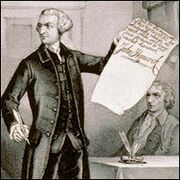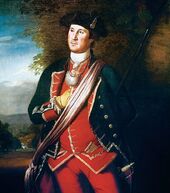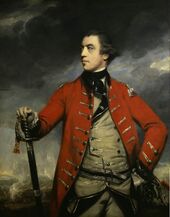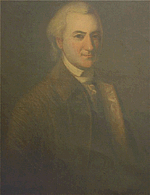
John Hancock of Massachusetts.
The North American Rebellion (1775 - 1778) was an uprising among the colonists of British North America that marked the final phase of the American Crisis. Although unsuccessful, the Rebellion led to the granting of limited self-rule to the colonists under the Britannic Design of 1781.
Origins[]
Since the end of the French and Indian War in 1763, there was growing friction between the colonists and the British government, centered on the question of whether Parliament had the right to impose taxes on the American colonies. In 1774 Parliament passed a series of acts to punish the Massachusetts colony for the Boston Tea Party, including revoking the colony's charter and closing Boston to commerce. The colonists responded by organizing the First Continental Congress, which called on the Massachusetts colonists to resist British authority and organized an embargo of British goods throughout the colonies.
The rebel colonists in Massachusetts formed an illegal shadow government called the Massachusetts Provincial Congress on 7 October 1774 under the leadership of John Hancock. The Provincial Congress began raising militia to resist the rule of General Thomas Gage, who had been appointed Royal Governor of the colony earlier in 1774. In January 1775 Gage received orders from the British government to take stronger measures against the rebels. The following month, Massachusetts was declared to be in a state of rebellion.
Outbreak of the Rebellion[]

A contemporary engraving of the clash at Lexington.
The North American Rebellion began on 19 April 1775 when General Gage ordered 700 British troops to arrest Hancock and Samuel Adams in Lexington, and then capture and destroy military supplies in the town of Concord. Hancock and Adams were warned of the coming British troops around midnight, and both fled from Lexington. The warning also reached Concord in time for most of the military supplies to be removed to nearby villages.
The British troops reached Lexington by sunrise, where they clashed with the local militia. After reaching Concord the British force divided into companies to search for the military supplies. As rebel militia gathered around Concord fighting broke out between the two forces, resulting in a running battle that continued until the British troops returned to Boston. The rebels placed Boston under siege, which lasted until British troops withdrew from the city in March 1776.
When the Second Continental Congress convened in Philadelphia on 10 May 1775, it found itself forced to deal with the ongoing armed rebellion in Massachusetts. The Congress chose to take command of the rebel militia, incorporating it into a Continental Army and appointing Colonel George Washington of Virginia as its commander-in-chief. Later that year, the Congress sent rebel armies under Richard Montgomery and Benedict Arnold to seize Quebec, but they were defeated by Governor Guy Carleton, and driven back the following spring.
Independence and Military Setbacks[]

George Washington of Virginia.
By the spring of 1776, under the influence of radical agitator Thomas Paine's inflammatory pamphlet Common Sense, popular opinion among the colonists had swung decisively in favor of independence. The Congress, led by John Adams of Massachusetts, Thomas Jefferson of Virginia, and Benjamin Franklin of Pennsylvania, declared independence from Britain in July, naming their new nation the United States of America.
Gage had been recalled to Britain following the outbreak of the Rebellion, and General William Howe had been appointed to replace him as commander of British forces in America. After Howe withdrew from Boston in March 1776, Washington expected him to immediately make an attack on New York City. However, Howe chose to retreat to Halifax, Nova Scotia for several months to regroup and await the arrival of reinforcements before beginning his occupation of New York in September 1776.
Washington was forced to retreat again and again during the fall of 1776, from New York City, from Brooklyn, from Long Island, from Staten Island, and finally across New Jersey to Pennsylvania. However, he was able to forestall the collapse of the Rebellion for a time by making successful attacks on Trenton and Princeton, forcing the British to retreat back to New York City.

General John Burgoyne.
The following spring, the British resumed their offensive, launching coordinated attacks against Philadelphia and Albany, New York. General John Burgoyne led the northern attack, marching south from Quebec, while General Howe led the southern attack, landing at the head of Chesapeake Bay in Maryland and marching north. Washington was compelled to divide his forces, sending Generals Horatio Gates and Arnold north to oppose Burgoyne, while leading the bulk of the rebel army south to fight Howe. Washington was driven steadily back by Howe, while Burgoyne found himself forced to halt 25 miles north of Albany by Gates and Arnold.
Howe was able to occupy Philadelphia on 26 September 1777, forcing the Congress to flee to York, Pennsylvania. The Loyalist leader Joseph Galloway was placed at the head of a civil government in the city. In the north, General Sir Henry Clinton set off north from New York to relieve Burgoyne's stalemated force. The two men were able to effect a joint attack on Gates and Arnold on 21 and 22 October in the decisive Battle of Saratoga, destroying the rebels' northern army, and forcing Gates to surrender on 25 October. In the south, an attempt by Washington to drive Howe out of Philadelphia at the Battle of Germantown on 4 October was unsuccessful, and he was forced to withdraw the remnants of his army to Valley Forge.
British Victory[]

John Dickinson of Delaware.
Growing opposition to Washington's military leadership in Congress led to a reorganization of the Continental Army in February 1778, with Washington being made subordinate to General Artemas Ward. Washington preferred to resign his commission, doing so on 16 February.
With the battlefield losses, and the loss of any hope for aid from the French, a moderate faction led by John Dickinson gained control of the Continental Congress. Dickinson persuaded the Pennsylvania assembly to appoint Galloway to the Congress, and the two men began peace negotiations with a commission led by the Earl of Carlisle in April. The negotiations led to an armistice in June 1778 ending the Rebellion and returning the colonies to British control.
General Burgoyne became military governor of the mid-Atlantic colonies, while Carleton, Howe, and General Charles Cornwallis served as military governors of the other rebellious colonies in the era of the Four Viceroys. The leaders of the Rebellion, including Washington, Jefferson, the Adams cousins, Richard Henry Lee, and Paine, were arrested and sent to London to stand trial for treason. All were sentenced to death except Washington, who was given a life sentence. Some former rebels left the colonies to join the Wilderness Walk to the new settlement of Jefferson in the Tejas Province of northern Mexico.
In the wake of the Rebellion, Parliament passed the Britannic Design in January 1781, reorganizing British North America into the Confederation of North America.
This was the Featured Article for the week of 6 July 2014.
| C.N.A. Historical Eras |
|---|
| American Crisis • North American Rebellion • Four Viceroys • Britannic Design • Dickinson Era • Trans-Oceanic War • Era of Harmonious Relations • Crisis Years • Rocky Mountain War • Era of Faceless Men • Age of Renewal • Bloody Eighties • Creative Nationalism • Starkist Terror • Years of the Pygmies • Malaise Years • Diffusion Era • Global War • New Day • War Without War |
